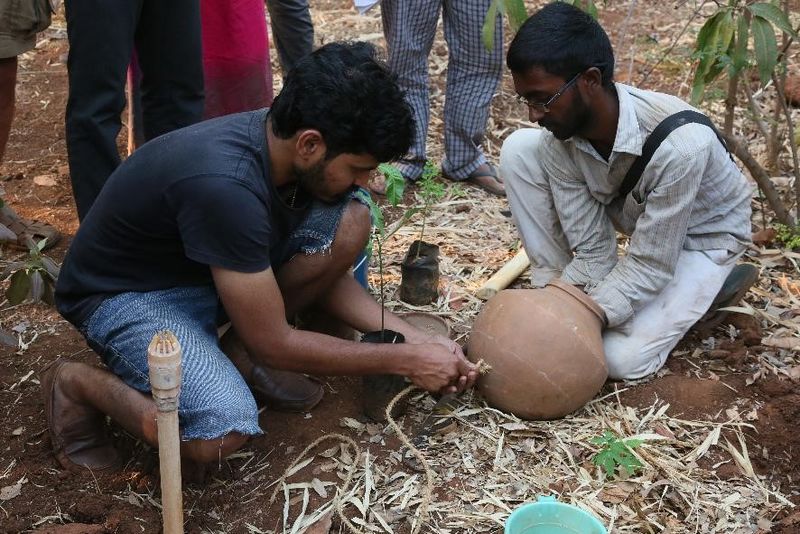• Improve irrigation efficiency, • Improve young tree survival rate, • Rehabilitate degraded areas.
Rehabilitation of the forest offers many other benefits such as soil rejuvenation, life-friendly microclimate development, biodiversity enhancement, water retention and so much more.
Introduction
Acknowledgements
Young trees need care such as protection (e.g. fencing), nutrition and watering! Lack of proper care lead to high death rate in young trees. I visited some projects with 80 to 90% death rate in young trees because of lack of water… Water is precious and human action has often lead to and keeps on aggravating water scarcity issues. During our journey through Africa and India, we acknowledged how severe the issue is and truly understood the value of water… Some irrigation solutions use a lot of water and, in dry climates, evaporation make those systems inefficient. Some irrigation solutions are costly and require technology that are not accessible to some communities in dry areas. On the other hand, protracted thoughtful landscape work and adapted irrigation solution can improve the situation and, with the rehabilitation of the degraded area, lead to solving the water scarcity issues. Many examples of “greening the desert” are available and documented.
Our solution and its expectable benefits
Use a clay pot berried in the ground and low-tech to irrigate young trees to:
- Improve irrigation efficiency,
- Improve young tree survival rate,
- Rehabilitate degraded areas.
Rehabilitation of the forest offers many other benefits such as soil rejuvenation, life-friendly microclimate development, biodiversity enhancement, water retention and so much more.
"If we could only understand what a tree does for us, how beneficial it is to life on earth, we would (as many tribes have done) revere all trees as brothers and sisters." (B. Mollison)
Matériaux
- Parts:
- (1) Clay pot,
- (1) Concave clay plate (to close the pot),
- (1) Rope (use biodegradable rope, e.g. coconut fiber rope);
- Consumables:
- Water,
- Seeds (leguminous );
Outils
- Tools (see FAQ & Troubleshooting? For other alternatives):
- (1) Hammer,
- (1) Nail (thin),
- (1) Nail (thick);
Étape 1 - Make a hole in the clay pot
- Use a small/thin nail to make a hole (pre-hole) on the side of the clay pot,
- Use a big/thick nail to make the hole the same size as the diameter of the rope;
Étape 2 - Install the rope in the clay pot
- Insert the rope in the hole in the clay pot,
- Make a knot on the rope at several centimeters of the end of the rope inside the clay pot,
- Make a knot on the rope outside the clay pot to secure the rope with the clay pot,
- If you want to irrigate more than one plant, repeat the steps above;
Étape 3 - Install the clay pot
- Define the planting location to define the zone where you want to install the clay pot:
- Make sure that the pot will be above the plantation pit,
- Make sure that the rope will come out of the clay pot at an angle and go down to the young tree root system (↘or ↙);
- If possible, define if you want to burry most of the clay pot or not,
- Dig a hole for the clay-pot irrigation system,
- Dig a trench for the rope of the clay-pot-irrigation system at an angle to go down to the young tree root system (↘or ↙),
- Install the clay-pot irrigation system in the hole;
Étape 4 - Refer to the applicable procedure to plant the tree
Étape 5 - Add water in the clay pot
Étape 6 - Close the pot
- Install the concave clay plate on the clay pot,
- Add water in the concave clay plate,
- Plant legume seeds around the clay pot.
Notes et références
FAQ & Troubleshooting?
In our “acknowledgments” introduction, we mentioned landscape works. We want to provide you with a DIY procedure to build swales – coming soon! Feel free to ask questions and suggest other topics 😉
Go further…
Please share with us with your remarks, comments, improvements, achievements, etc.
DIY tutorial “Tree planting preparation (Sadhana Forest method)” procedure: http://wikifab.org/wiki/Tree_planting_preparation_(Sadhana_Forest_method)
DIY tutorial “Tree planting (Aranya method)” procedure: http://wikifab.org/wiki/Tree_planting_(Aranya_Agricultural_Alternatives_method)
Blogpost about the Permaculture Design Course at Aranaya Farm: https://sustainable-autonomy.weebly.com/blog/pdc-at-aranya-farm
Learn more about our projects: https://sustainable-autonomy.weebly.com/
Follow us on Twitter: https://twitter.com/Sustainomy/
Subscribe to our newsletter: https://bit.ly/2L1bbFz
Published

 Français
Français English
English Deutsch
Deutsch Español
Español Italiano
Italiano Português
Português